Fitbit Charge 5 Review: Big on features, low on utility
Summary
Quick verdict: The Fitbit Charge 5 takes a noticeable step up from its predecessor by adopting a number of key fitness tracking features from the Sense and improving the screen. But flaws in its functionality, battery life and subscription model can’t be ignored.
- Tons of features
- Still a solid price for wide-ranging tracking
- Small footprint and light
- Premium subscription too aggressive
- Battery life a headache
- Touchscreen interface is poor
With its latest wearable, Fitbit seeks to upscale its Charge fitness tracker range with features from its high-end Sense model.
On paper, it certainly seems like you're getting a lot for the price. However, in my many weeks wearing the Fitbit Charge 5 I came across a number of issues in its design and battery life that hampered its utility. And while there's no doubting the Fitbit Charge 5 is feature-rich, said features are too often just carrots dangling in front of a Premium subscription service.
Let's walk through my experience in this Fitbit Charge 5 review, as we head towards a 10,000-step goal. Can the Fitbit Charge 5 break into our best fitness trackers of 2022? Or earn a respectable rank when you compare the best Fitbit in Australia?
Fitbit Charge 5 vs Charge 4
At a glance, you'd be hard-pressed to tell the difference between the Fitbit Charge 5 and its predecessor, the Charge 4. Unlike the Fitbit Sense, the Charge 5 retains the small physical footprint. The rectangular screen is not even as wide as the wrist strap.
But on closer inspection, you may notice that the Charge 5 is thinner and lighter than the Charge 4. There are also stainless steel strips down both edges of the screen.
The stainless steel strips are there to scan 2 new metrics to the Charge range: electrodermal activity (EDA) and electrocardiogram (ECG) scanning. These features come across from the Fitbit Sense, alongside heartrate notifications and a Daily Readiness score, as new features for the Charge range. They come at the expense of the altimeter, so no more counting altitude/steps.
Other notable improvements over the Fitbit Charge 4 vs Charge 5 include a colour display that's twice as bright as its predecessor, the option to go with an always-on display, and the 3 colour options: Black, Lunar White and Steel Blue. Note that the wristbands from previous Charge fitness trackers are not compatible with the Charge 5. Boo!
Features
As mentioned above, the Fitbit Charge 5 brings to the table key features previously seen in the Fitbit Sense, namely EDA, ECG, heartrate notification and Daily Readiness reports. The latter analyses your metrics to define whether any given day is fit for recovery or exercise. But it's also notable for being locked behind the Premium subscription service.
I will talk about the Premium service later, but at least you do get 6 free months of the subscription with your purchase. That's $90 in value.
Elsewhere, the Fitbit Charge 5 will track your steps, of course, and your SpO2 levels, sleep, stress, breathing rate, skin temperature, calories burned and active minutes automatically. The interface allows you to add in metrics like food, water, weight, menstrual cycle and mood via the mobile app manually.
There are 20 exercises that can be started manually, but are also identified by the watch if you forget to do so. Notably, only 6 can be quick-accessed at any time.
One feature I quite like is Smart Wake, which works out the optimal time to stir you from slumber. For example, set your alarm for 7am and if the tracking shows you're coming out of a sleep cycle at 6.50am it'll jump the gun for you to lessen the blow. Fitbit Pay is handy, too.
As mentioned, there's no altimeter this time around. If you were hoping for improved ability to store or control music, or to use voice commands, you'll soon discover they're still missing. But there is a built-in GPS, and alerts for phone notifications, excess idle times and heartrate extremes. You can also set an alarm or start a countdown clock.
The watch touts itself as having a 7-day battery life, but that's laughable. I'll dive into that issue deeper when I talk about performance. Speaking of diving, it's also "swimproof", in the least compelling way imaginable.
Design
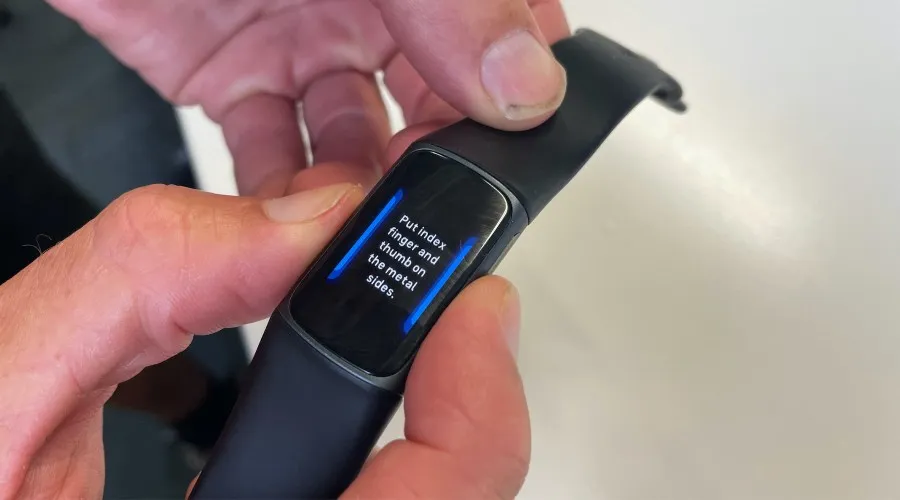
Image: Chris Stead/Finder
As a fitness tracker on the cheaper end of the scale, the Fitbit Charge 5 doesn't make much of a fashion statement. Unless you count "meh" as a statement. As mentioned at the top, there's little innovation here over the Charge 4. I don't mind that. If you're opting for this wearable, its subtle footprint and barely-there 28g weight are in truth a selling point.
I tend to get used to any wearable quickly enough, even if it's heavy and noticeable when I first put it on. With the Fitbit Charge 5 there's next to no getting used to it, as you can hardly feel it. A win, no doubt.
There's nothing exciting about the stock colour choices, which is potentially by design to encourage you to spend more on Infinity Bands. Spot the cynic, right? A lack of compatibility with previous Charge bands and a lack of diversity in available bands at the time of writing – no metal, for example – adds salt to the wound.
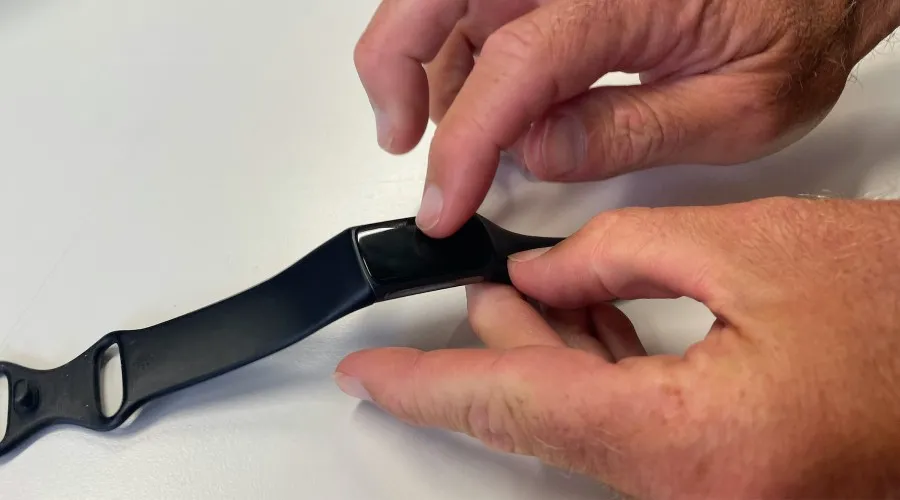
Image: Chris Stead/Finder
I'm not sure if I like the clasp system or not. It's not traditional. Rather than pulling it tight and feeding the little bees-dick thing through a hole, you simply wrap it back over a little nub. It's not as easy to do and it gives the impression of being less secure. But it's never come undone on me. So…
Touchscreen and water issues
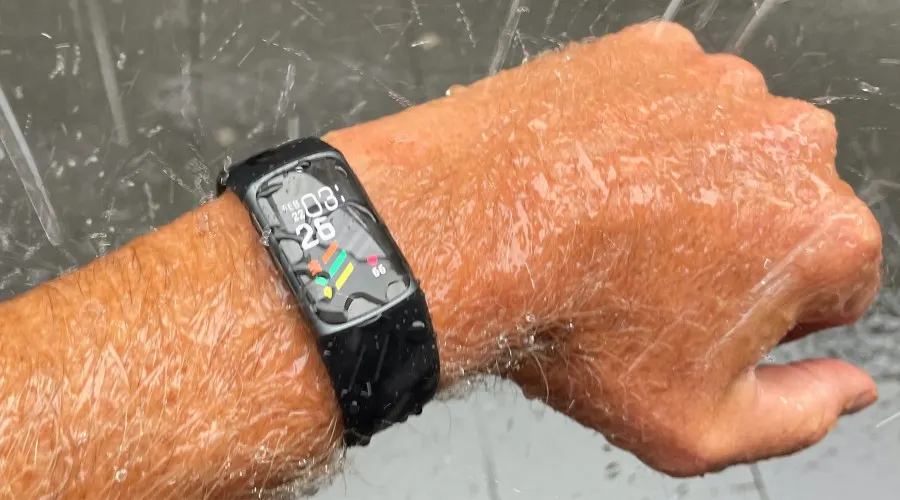
Image: Chris Stead/Finder
I hate the touchscreen. It's a nightmare. You'll want to make sure you set your watch to (the battery-consuming) auto turn on when you raise your wrist, because the alternative is a screen double tap. This is hit and miss in the extreme. The number of instances where I was forced to tap it 4, 5 or even 6 times to get a result was ridiculous.
Swiping between settings and operating activities is also a catalyst for frustration. Swipe success rate is probably about 60%. The rest of the time it just sits there staring back at you in stunned silence. And if there is something to interact with on a screen you're swiping past, you'll toggle it way too frequently. I longed for an analogue dial that doubled as a push-in button.
This problem is amplified if you wear the device while swimming. As soon as water is on the screen it's rendered near useless. You could set a woodpecker to tapping it and get nowhere.
Another curiosity that beggars belief is that when you activate an exercise, you can no longer see the time. It just shows you the activity timer. For me, I'd be out surfing and wonder what time it is and have to stop the exercise to find out – which you can't do, because the stupid touchscreen doesn't work in the water. Argh!
If swimming or water-based activities are a key part of your fitness regime, give the Charge 5 a wide berth. I get the impression Fitbit won't mind. While they call the Charge 5 "swimproof", the company doesn't appear that confident in the claim. The documentation asks you to water-lock it first, and try to avoid soap and to ideally just take it off altogether.
That lack of confidence certainly carried across to my own uneasiness, although to be fair, I got pounded by 10ft waves wearing it and the Fitbit Charge 5 carried on its business. But for how long will it do so? I'm nervous.
Performance
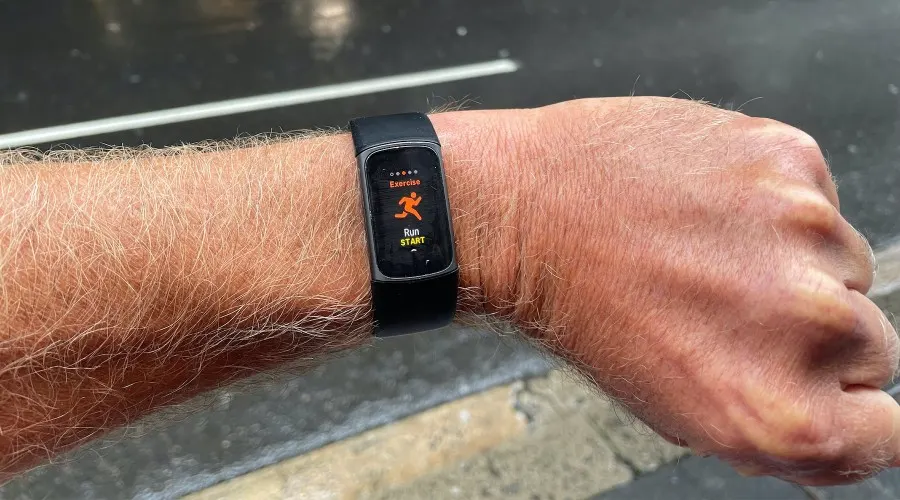
Image: Chris Stead/Finder
The Fitbit's primary function is as a fitness tracker. Distil it just down to this use case and it performs solidly enough. My main beef is that there's still too much falsification of steps on account of random arm movements. When you compare it to the best-in-class step tracker – which is in my opinion the Withings ScanWatch – there's a lot of freebies handed out.
For example, I've woken up, had a shower, done a bunch of sit-ups and push-ups, made breakfast, and somehow been pushing 2,000 steps. It tracks too many inconsequential movements. But does the number really matter? It's a yardstick to compare yourself against day-to-day. As such, my tip is to not worry too much about the pure accuracy of it and set a higher step count goal to mitigate.
In regards to all the other tracked metrics, you have to take Fitbit's word on it to a certain extent. I can count my steps manually, but not my Sp02! What I can say is that the Fitbit Charge 5 was sending me back stats that were in line with what other fitness trackers have said. So, I'm willing to believe the tracking is on the money.
I've previously detailed my displeasure with the touchscreen's performance. Overall, the whole UI is a little on the sluggish side with a micro-second of lag. The app, though, is easy to navigate and supplies a wealth of information for you to sift through and engage with.
Battery bummer
What I'm not okay with is the battery life. It's woeful. The advertised 7-day lifespan isn't that great to begin with, but during my testing time I don't think I made it to 5 days once. And that was with "auto on" set to off! You can probably bank on 4 days most of the time. But if you exercise a lot that could come down to 3 as turning on an activity seems to be the biggest drain on the battery.
By comparison, I've used other fitness trackers that last so long that it's a surprise when you have to charge it. We're talking weeks!
Sure, you can get into the habit of sitting down at your desk and plugging it in. But that's a pain in the butt. The number of times I did this and then went for a walk forgetting to put it back on was legion. Worse, the thing kept going flat when I was away from the charger or asleep. This leaves holes in your data, impacting not just the day-to-day metrics, but those that depend on multiple concurrent days to be of any use.
Fitbit Premium
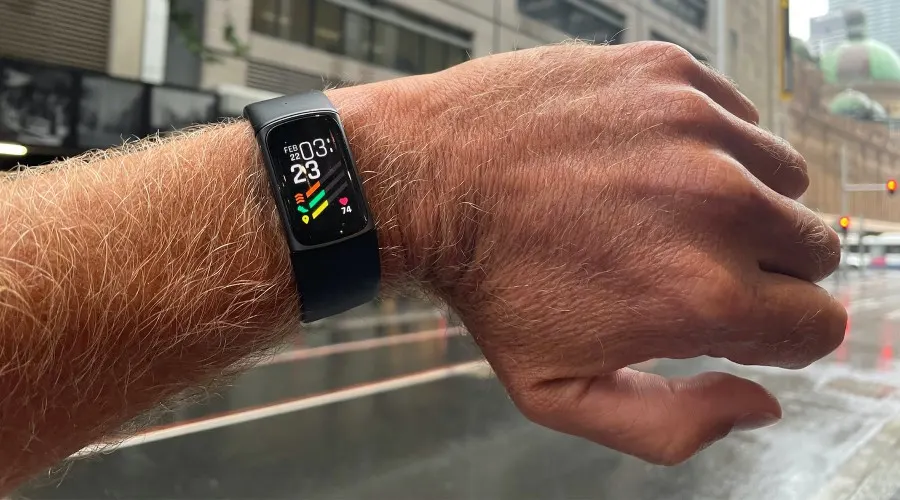
Image: Chris Stead/Finder
Here's where I stand when it comes to premium subscription services for any tech device. If said subscription service is offering something that requires human input, I can understand it being behind a paywall. If it's just rearranging and displaying data already acquired – as in, completely automatic and nominal – then it shouldn't be behind a paywall. Especially given the value of that data to the company's R&D and partners.
Fitbit Premium costs $14.99 per month or $119.99 per year. 6 months is included for free with your purchase.
The things it unlocks that fit into column A for me are the 45+ mindfulness sessions, 150+ video workouts and video recipes; even showing and tracking running routes, to a certain extent. That kind of content adds value and there's some justification for paying extra for it.
Everything else shouldn't be there. Daily Readiness, stress management analytics, advanced sleep score analysis, personalised insights, month-long trend data and customised challenges are just the same Excel spreadsheet looked at from a different angle – it's existing data already tracked by the device you've purchased. Fitbit is choosing not to share it with you unless you pay more.
To that I flip the bird. These elements shouldn't be behind a paywall in my opinion and the value of the Fitbit Charge 5 is poorer for it.
Should you buy the Fitbit Charge 5?
- Buy it if you're looking for a lot of features at a reasonable price and a wearable with a small footprint.
- Don't buy it if you lack touchscreen and battery patience, or intend to swim for exercise.
When I wasn't actively trying to use the Fitbit Charge 5, I quite liked it. It's light and small, hanging out on my wrist almost unnoticed while tracking a huge range of metrics. The app supports it well, allowing you to keep a diary of a host of other health-related information that can get you on the right path to a better life.
It's not that expensive either, Premium subscription aside.
However, when you actively use it, the Fitbit Charge 5 becomes a punish. The touchscreen is unresponsive and annoying. It may be "swimproof", but it's swimming unfriendly. The battery life is dire. Inexplicably, you can't see the time when you're exercising. Meanwhile, key data is locked behind a subscription paywall.
When you're weighing up the bang for buck offered by the Fitbit Charge 5, these failures don't necessarily rule it out. But you'll definitely want to go in with your eyes open and be comfortable with what you're not getting for the saving in cash.
Pricing and availability
The Fitbit Charge 5 is available now and retails for $269.95 in Australia, which is around 17% up on the launches of previous Charge fitness trackers. I've seen it for around the $250 mark on the likes of eBay and Amazon, so there's not much wiggle room in that price either. By comparison, the Fitbit Sense is around the $450 mark.
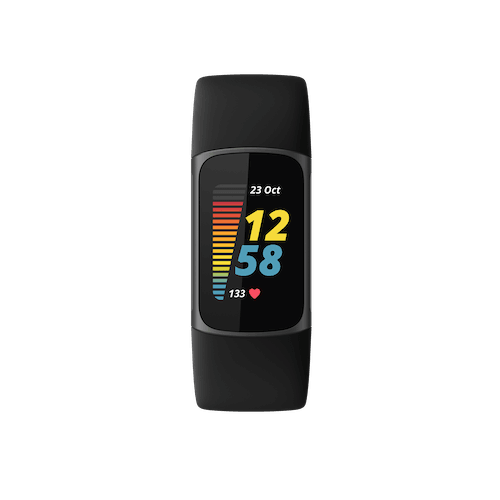
How we tested it
I wore the Fitbit Charge 5 every day for over a month. This included using it during all my exercise routines – notably surfing – as well as my day-to-day activities and sleep. I've reviewed numerous fitness trackers in the past from both the Fitbit range and its alternatives.